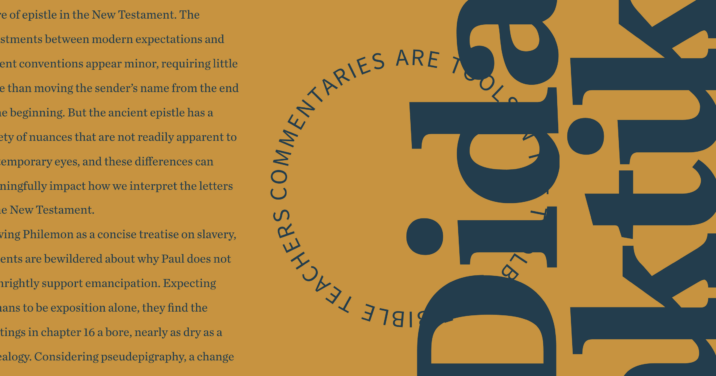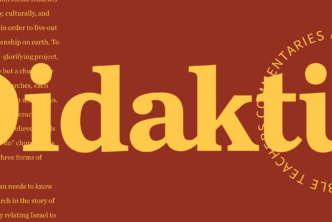There might seem to be little need to explain the genre of epistle in the New Testament. The adjustments between modern expectations and ancient conventions appear minor, requiring little more than moving the sender’s name from the end to the beginning. But the ancient epistle has a variety of nuances that are not readily apparent to contemporary eyes, and these differences can meaningfully impact how we interpret the letters of the New Testament.1
Viewing Philemon as a concise treatise on slavery, students are bewildered about why Paul does not forthrightly support emancipation. Expecting Romans to be exposition alone, they find the greetings in chapter 16 a bore, nearly as dry as a genealogy. Considering pseudepigraphy, a change in amanuensis would never enter their minds as a possible explanation for the change of style between 1 Peter and 2 Peter. And on the topic of canonization, my students struggle to find any value to 2 and 3 John.
The underlying problem in all these cases is a tendency to think of the Bible as a series of books undifferentiated by genre, abstractly disclosed from on high, rather than composed by flesh-and-blood people (if also divinely inspired!) in distinct ways at specific times and circumstances.
Nor is the problem simply the elapse of two millennia. Few in the contemporary world write physical letters anymore. Indeed, if my inbox is any indication, writing a well-structured email is itself becoming a lost art among college students. Communication is now electronic, at the length of 140 characters, and peppered with emojis.
The letters of the Bible are not as familiar as they seem.
The pedagogical purposes: (1) to understand through experience the process of writing a letter in the ancient Mediterranean world; (2) to reinforce the major sections of an ancient letter.
Description of the exercise
In a smaller class (five to fifteen students), usually with majors and minors in theology, we replicate writing an ancient letter, accommodating somewhat to the practical realities of a contemporary classroom. The assigned reading for the day is E. Randolph Richards, “Paul, the Letter Writer,” which provides an overview of the form of Roman-era epistles, as well as the process and cost of writing and sending them.2
We only briefly review Richards’s major points (about five minutes) before we write a letter together (30–40 minutes). I pick volunteers for author, scribe, and letter-carrier, with the remaining students providing input on the content and sending their greetings at the end. I often prearrange the recipient, a colleague in the department who will be in the office during our class time.
The underlying problem is a tendency to think of the Bible as a series of books undifferentiated by genre, abstractly disclosed from on high, rather than composed by flesh-and-blood people (if also divinely inspired!).
With the help of her peers, who use a chart in “Paul, the Letter Writer,” the author recalls the major sections of a letter: the opening (with a prescript and prooimion), the body (with an opening, middle, and end), and closing (with an epilogue and postscript). Then the author must decide how to fill in these sections, with no more than a sentence or two apiece. Usually, the class suggests many options to the author.
The scribe is at the whiteboard, jotting down a rough draft of the letter, and with some frequency the scribe’s own wording makes it into the letter. Once we have completed the draft, I have the author review the letter and approve the final wording, encouraging her to make some changes.
Then the scribe copies the finaversion to a piece of notebook paper, while I debrief with the rest of the class about the exercise. Once the scribe has finished, the author writes the postscript in her own hand. The letter is folded accordion-style, then in half, and the letter-carrier takes it to the office of our recipient and reads it aloud to him. The whole class invariably wants to eavesdrop on this reading, which I allow.
The letter typically looks something like this:
Mackenzie, the most excellent student,
To the honored Dr. Black: greetings.
I hope you are well and in a generous grading spirit.
I am thankful for the work you do as a professor, and I pray for your continued excitement as you teach. I wanted to write to you on behalf of the theology and ministry students about our upcoming midterm in your class. We have been working hard, but we realize that we do not understand all the material yet. We hope that you will be merciful when you write the exam and generous when you grade it. Do not lose heart in teaching us, but also remember that the material is difficult.
I look forward to seeing you tomorrow in class. Jordan, who wrote down this letter, also sends his greetings. So do the other members of New Testament Epistles: Zeke, Jalen, Paige, Shawn, and Maddie, who is delivering this letter to you. Farewell!3
Obviously, some of this remains removed from the ancient world. I substitute a whiteboard for a wax tablet and allow the use of a desk for writing the final copy. The scribe is certainly not making his own ink and papyrus! Still, it approximates the process, and I note where we are departing from the ancient reality. Adjustments might be required in another setting.
For example, since our college is small, the students will all know the professor I have chosen as a recipient, and our offices are close to the classrooms in which we teach. So we can write a letter to a known individual and actually send it to him. At another institution, the recipient and sending process might need to be hypothetical, but much of the exercise would transfer.
Why and how it is effective
Composing an ancient letter for themselves requires students to create, which is the highest level of learning on Bloom’s taxonomy. Because the process and roles of writing a letter (purpose 1) have been embodied, I find that students easily recall them. Later in the semester, for example, they notice Tertius the scribe in Romans 16:22, and they also have a sense for how much work would go into even a short letter like Jude.
Likewise, students understand the sections of an ancient epistle (purpose 2), so that Paul’s quick transition in Galatians to a stinging rebuke, dropping the expected thanksgiving, is noticeable to them. Overall, the exercise makes studying the epistles much more intuitive for students, compared to a lecture about the form and process of letter-writing. As a bonus, students generally find the activity fun.

***
This article was originally published in the October 2022 issue of Didaktikos. Slight adjustments, such as title and subheadings, may be the addition of an editor.
Related articles
- Studies in the Pauline Epistles: Essays in Honor of Douglas J. Moo
- How to Teach for Different Generations
- How to Interpret the Bible Correctly: Paul’s Epistle to the Romans
Related resources
Paul and First-Century Letter Writing: Secretaries, Composition and Collection
Regular price: $12.99
Ancient Letters and the New Testament: A Guide to Context and Exegesis
Regular price: $35.99

Rediscovering Paul: An Introduction to His World, Letters, and Theology, second edition
Regular price: $27.99
- Two helpful works are E. Randolph Richards, Paul and First-Century Letter Writing: Secretaries, Composition and Collection (Downers Grove, IL: InterVarsity, 2004) and Hans-Josef Klauck, Ancient Letters and the New Testament: A Guide to Context and Exegesis (Waco, TX: Baylor University Press, 2006).
- E. Randolph Richards, “Paul, the Letter Writer,” in Rediscovering Paul: An Introduction to His World, Letters and Theology, ed. David B. Capes, Rodney Reeves, and E. Randolph Richards (Downers Grove, IL: IVP Academic, 2007), 54–82. Incidentally, even apart from the exercise in class, I have found this to be a reading students greatly enjoy.
- This letter, including the names, is fictitious, but it is realistic to the letters I have seen students compose.





